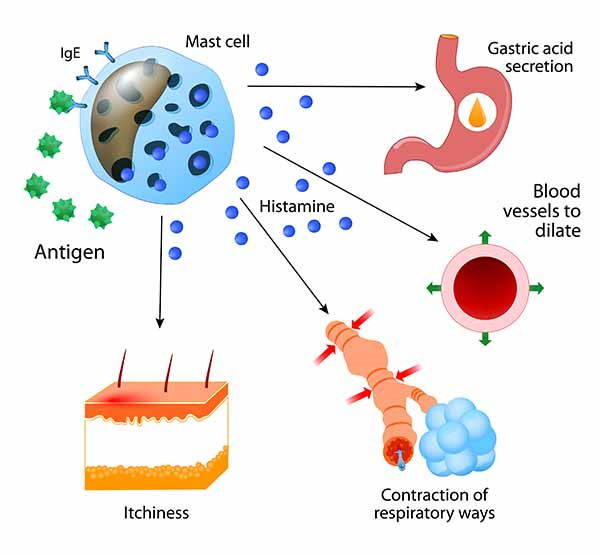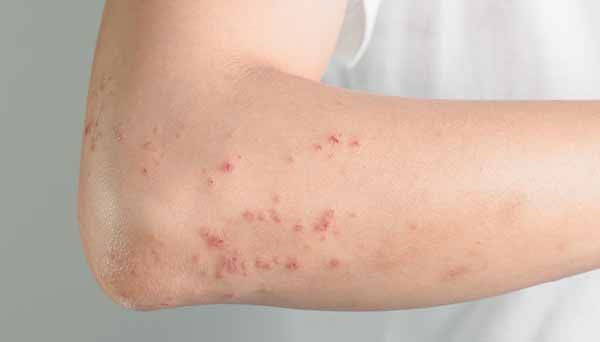People who suffer from some allergies certainly know histamine, a substance that our body produces in response to the presence of an allergen which can be a food, a plant, etc. However, there is also an intolerance to histamine. Let's find out the symptoms that may appear and any remedies.
Don't store avocado like this: it's dangerous
People who suffer from any allergies certainly know thehistamine, a substance that our body produces in response to the presence of an allergen which can be a food, a plant, etc. However, there is also an intolerance tohistamine. Let's find out the symptoms that may appear and the any remedies.
Just like food intolerances such as gluten or lactose, it is possible (although rarely) to suffer from an intolerance to histamine due in particular tointake of certain foods that are rich in it.
But let's start from the beginning, what is meant by histamine and what role does it play in our body?
Index
WHAT IS HISTAMINE
Histamine is a substance found in virtually all plant or animal organisms and acts as a chemical mediator in some reactions of our body that contains this substance especially in the cells that deal with allergic responses.
Our organism, in fact, produces it in particular as response to an allergen. It therefore serves to alert the body that something foreign and therefore potentially dangerous is present. Very high levels of histamine lead to the appearance of reactions allergic, then in some cases we resort to taking natural antihistamines.
However, few know that histamine is also contained (in different quantities) within some foods. The problem arises when there is no balance between the intake or release of histamine and the degradation of this substance by an enzyme called diaminooxidase (DAO) which prevents its absorption within the small intestine.
Generally a healthy person is able to managehistamine from food sources or released in response to the intake of certain foods thanks to this enzyme. However, if there is an intolerance to histamine, the enzyme in charge cannot perform its function correctly as it is not found in the body in the right quantity. Here then appear some symptoms.

SYMPTOMS OF HISTAMINE INTOLERANCE
I symptoms of histamine intolerance they are very similar to those of a classic food-related or non-food allergic reaction. So we can see it appear abdominal cramps, stomach pain, diarrhea, flutolence, itching and hives, headache, asthma and breathing difficulties, stuffy nose, irritation and itchy eyes, tachycardia and dizziness.
Generally it takes about 40 minutes after taking a food rich in histamine to see these annoyances arise. Sometimes, however, given that the content of this substance is variable, it may be that the same food may or may not trigger the reaction depending on the case. Often a strong symptomatology appears when more histamine-rich foods are eaten and for a certain period of time.
In summary, the possible symptoms of histamine intolerance are:
• Abdominal cramps
• Stomach ache
• Diarrhea
• Flautolence
• Itching and hives
• Headache
• Asthma
• Respiratory difficulties
• Stuffed nose
• Irritations
• Itchy eyes
• Tachycardia
• Dizziness

TEMPORARY OR PERMANENT INTOLERANCE
Intolerance to histamine it can be a temporary or permanent situation, the first much more frequent, the second instead affects only 1-2% of the population, in particular women over 35 years of age.
A temporary intolerance can arise for example when one has overdone alcohol or with foods that contain a lot of histamine, circumstances in which the enzyme capable of degrading this substance in the intestine is inhibited for a certain period of time, causing headaches, nausea, gastrointestinal problems, etc.
The classic "hangover" so it's nothing else a temporary intolerance to histamine.
DIAGNOSIS
It is not easy to link symptoms to histamine intolerance as the gastrointestinal ones are easily confused with colitis, those affecting the skin with dermatitis and eczema or hives (which can be due to various causes) or breathing difficulties and stuffy nose due to allergies related to the inhalation of some volatile substances in the air .
The diagnosis is therefore difficult also because since it is not a real allergy and therefore not a problem that affects the immune system, it cannot be found with traditional allergy tests.
Substantially the diagnosis is made on the basis of symptoms and any improvement of the same once the patient has been subjected to a histamine-free diet. Therefore, since there are no reliable tests in this regard, it is proposed to the person with suspected intolerance to eliminate for a few weeks foods that contain histamine or are histamine-liberating.
FOODS RICH IN HISTAMINE
There are several foods that contain histamine. In reality we need to make a clarification, some foods have histamine in them mainly due to some treatments to which they have been subjected, others, on the other hand, are able to make our body release this substance once ingested.
The formation of histamine inside foods requires particular conditions: the presence of free amino acids, microorganisms, bacteria and the right conditions that allow their growth. This is why among the foods rich in histamine there are above all those subjected to seasoning, fermentation, maturation and prolonged storage in the warehouse. These include red wine, sparkling wine, cheeses, salami and speck, fish, seafood, sauerkraut, yeast but also some vegetables such as tomatoes, aubergines and spinach, ketchup and soy sauce and vinegar.
Particularly fish if stored poorly or for too long it can endanger your health as it is too rich in histamine. The riskiest fish in this respect are tuna, mackerel, sardines and canned herring. Several times we have reported food warnings that concerned too high levels of histamine in tuna or anchovy fillets.
As it regards instead foods that release histamine and that therefore contain little of it inside them but which favor the release of this substance inside our organism we remember: chocolate, strawberries, pineapple, mushrooms, nuts and alcohol.
In summary, histamine-rich foods are:
• Fermented foods
• Seasoned foods
• Foods stored for a long time in warehouses
• Red wine
• Bubbly wine
• Cheeses
• Salami
• Speck
• Fish (especially tuna, mackerel, sardines and herring)
• Seafood
• Sauerkraut
• Tomatoes
• Eggplant
• Spinach
• Ketchup
• Soy sauce
• Vinegar
Foods that make our body release histamine they are instead:
• Chocolate
• Strawberries
• Pineapple
• Mushrooms
• nights
• alcohol
We reiterate that generally a healthy person is able to manage histamine from food sources, but this does not happen if there is a specific intolerance to this substance.

WHAT TO EAT IN CASE OF INTOLERANCE
The diet suitable for those who suspect an intolerance to histamine is basically made up of fresh food therefore vegetables such as: salad, cauliflower, broccoli, carrots, garlic, pumpkin, beets, zucchini and asparagus and fruit such as apples, lemons, grapes, blueberries, peaches, plums, etc. You can eat them later pasta, rice, potatoes, cereals and pseudocereals, legumes, fresh milk, yogurt and fresh cheeses, only fresh meat and fish and eggs.
In case of intolerance, the diet must be based on the following foods:
• salad
• cauliflower
• broccoli
• carrots
• garlic
• pumpkin
• bieta
• zucchini
• asparagus
• mele
• Pere
• Lemons
• Grape
• Blueberries
• Peaches
• Plums
• Pasta
• Rice
• Potatoes
• Cereals and pseudo-cereals
• Legumes
• Fresh milk
• Fresh cheeses
• Yogurt
• Fresh meat and fish
• Egg
REMEDIES FOR INTOLERANCE
As already mentioned the first remedy for histamine intolerance is to follow a diet in which foods rich in this are avoided substance or that stimulate its release by our organism. Sometimes the doctor may also recommend vitamin supplements or some additional therapies, to be evaluated on a case-by-case basis.
Some remedies that can help are natural antihistamines first and foremost Vitamin C, the flavonoids, the omega 3, plants such as ginger, chamomile, echinacea, fennel, garlic, licorice root but above all the ribes nigrum, widely used in case of allergies.
It can help too drink green tea or rooibos.
Read also: NATURAL ANTHISTAMINS: 10 REMEDIES TO ALLERGIES
If you suspect an intolerance to histamine, contact your doctor for all the instructions to follow.


























